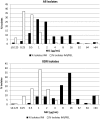Activity of Imipenem-Relebactam against a Large Collection of Pseudomonas aeruginosa Clinical Isolates and Isogenic β-Lactam-Resistant Mutants
- PMID: 31740559
- PMCID: PMC6985745
- DOI: 10.1128/AAC.02165-19
Activity of Imipenem-Relebactam against a Large Collection of Pseudomonas aeruginosa Clinical Isolates and Isogenic β-Lactam-Resistant Mutants
Abstract
Imipenem and imipenem-relebactam MICs were determined for 1,445 Pseudomonas aeruginosa clinical isolates and a large panel of isogenic mutants showing the most relevant mutation-driven β-lactam resistance mechanisms. Imipenem-relebactam showed the highest susceptibility rate (97.3%), followed by colistin and ceftolozane-tazobactam (both 94.6%). Imipenem-relebactam MICs remained ≤2 μg/ml in all 16 isogenic PAO1 mutants and in 8 pairs of extensively drug-resistant clinical strains that had developed resistance to ceftolozane-tazobactam and ceftazidime-avibactam due to mutations in OXA-10 or AmpC.
Keywords: Pseudomonas aeruginosa; antibiotic resistance; extensively drug resistant; imipenem-relebactam; multidrug resistance; whole-genome sequencing; β-lactam resistance mechanisms.
Copyright © 2020 American Society for Microbiology.
Figures
References
-
- Moya B, Zamorano L, Juan C, Pérez JL, Ge Y, Oliver A. 2010. Activity of a new cephalosporin, CXA-101 (FR264205), against β-lactam-resistant Pseudomonas aeruginosa mutants selected in vitro and after antipseudomonal treatment of intensive care unit patients. Antimicrob Agents Chemother 54:1213–1217. doi:10.1128/AAC.01104-09. - DOI - PMC - PubMed


